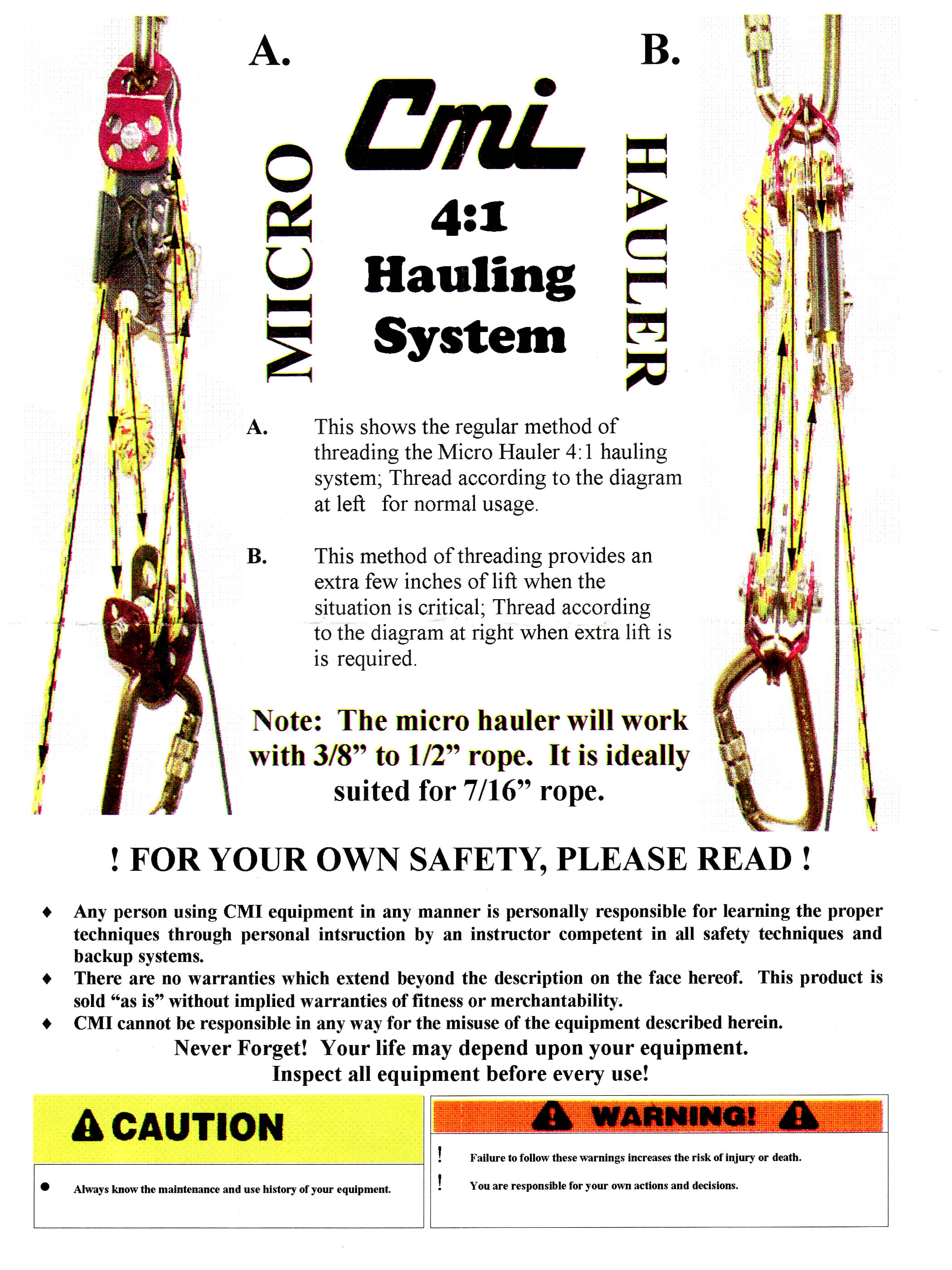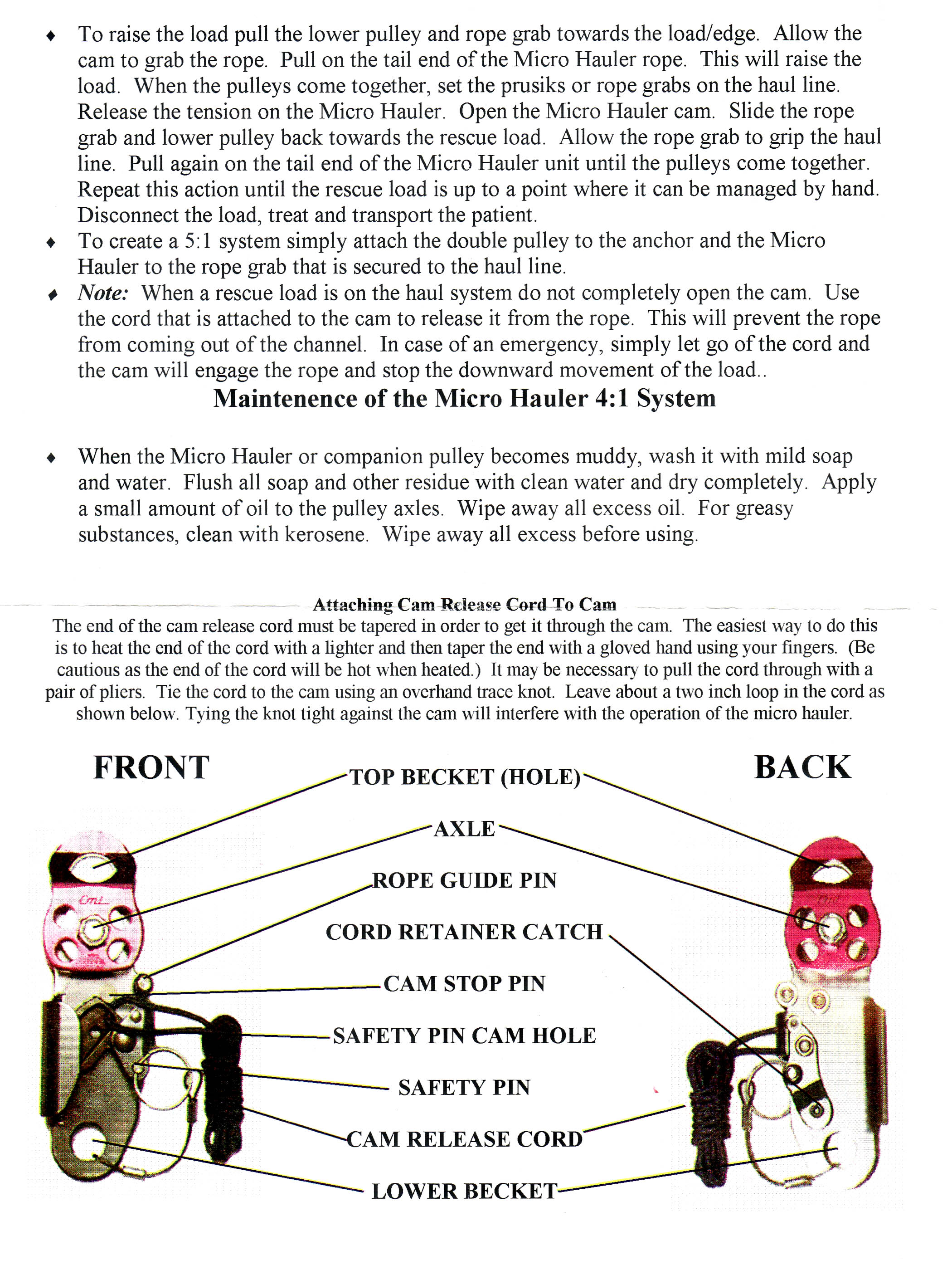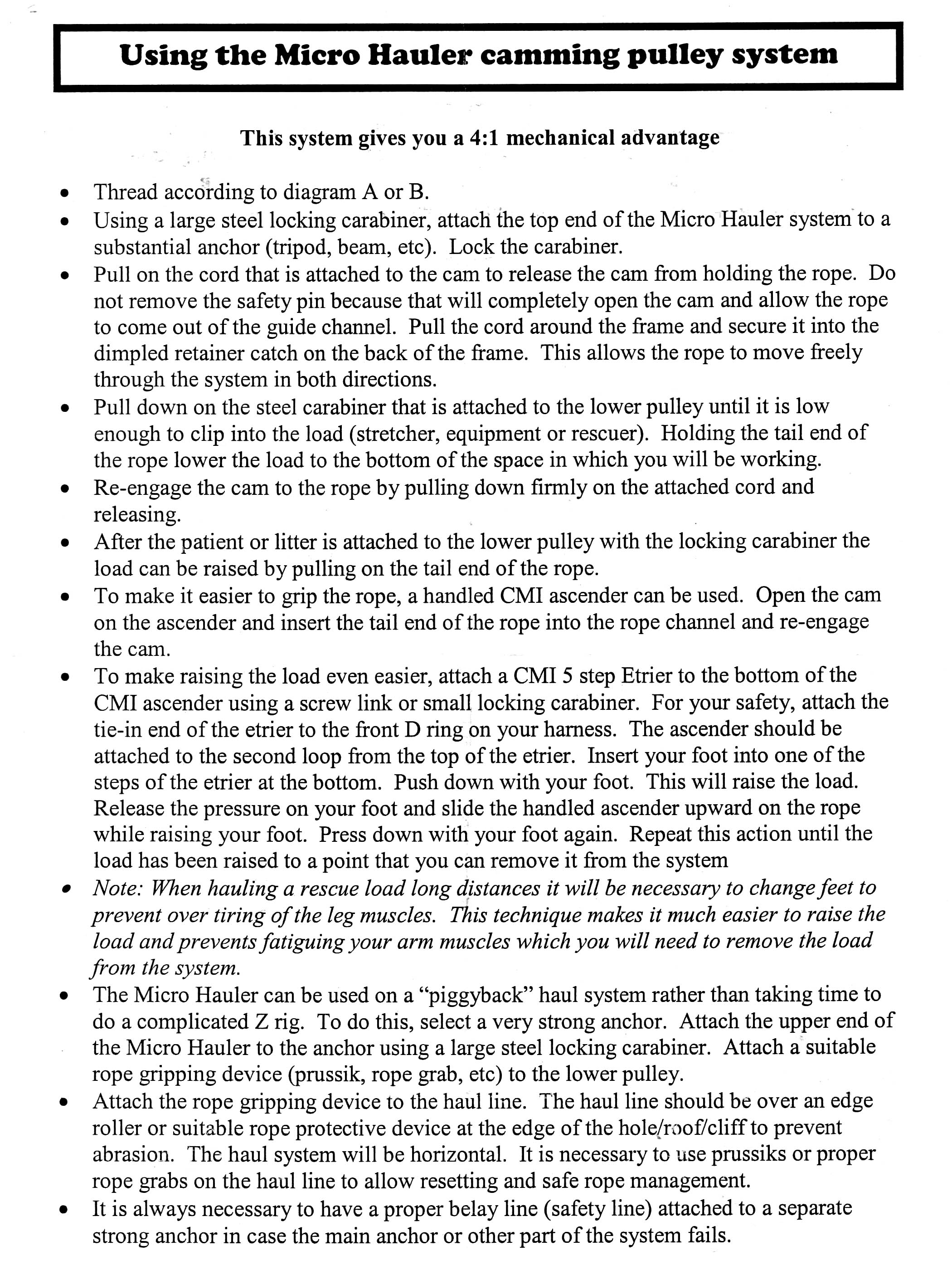Overview
[ Top
| Double
| Uplift
| Return to Hauling Pulleys
]
 Single Micro Hauler
Single Micro Hauler
(#832)
Technical Details
I acquired my CMI Double Micro Hauler from On Rope 1 in late
2005.
The CMI Single Micro Hauler is 154 mm. tall, 53 mm
wide, and 40 mm. thick. Mine weighs 19 g.
The CMI Single Micro Hauler is a single pulley with an eccentric
cam that prevents rope entry on one side. The central frame is
stamped and anodized 1/8" (3.2 mm.) aluminum. The right
side has a rectangular channel for mounting the cam and the left
side has a 15 mm. U-shaped channel for the rope. The frame
has a 22.3 mm. attachment hole at the top and a 16.34 mm
hole at the bottom. A pulley sits on an axle below the top hole.
The pulley has a 3.2 mm. aluminum stamped and anodized swinging
plate to hold the rope in. The plate has two bends to bring the
top in next to the frame, a 22.5 mm. hole for attachment,
and four lightening holes.
The pulley is 14.5 mm. thick aluminum and spaced about
2.5 mm. from the frame and the swinging plate. The pulley
has U-shape grooves, a 30.5 mm. peripheral diameter and a
21 mm. central diameters. The axle is 3/8" (9.6 mm.)
stainless steel, threaded for a nylon lock nut at each end. The
bearings may be oilite; they do not appear to be ball bearings,
but I didn't disassemble my Hauler to be sure.
The cam is cast steel with conical teeth in a (5.4.5)^2(4.3)^4(2)
pattern. It is spring-loaded and riveted in place. A 3 mm
cord is tied through a hole near the top of the cam, allowing
the cam to be opened remotely. A hole in the cam aligns with a
hole through the cam channel, allowing one to insert a 4.5 mm
pin to hold the cam open. The pin attaches to the lower frame
hole with two 25 mm. split rings and a 6-link flat chain.
An 8 mm. diameter cam stop is riveted to the frame above
the cam and below the front pulley. To its right is a 9.2 mm
post that serves as a rope guide. It has a turned U-shaped groove
that brings its minor diameter to 5.5 mm. On the back of
the frame there is a cord lock that is similar to the one on the
to the CMI Uplift and SRT
Rescuemates.
The swinging side plate is stamped "Cmi" and "MAX
7000 lb 31.1 Kn."
This is a small hauling pulley, but the directions make it
clear that it is designed for rescue hauling situations. It may
not run as smoothly as larger units (which might displease the
"bigger is better"
crowd) but it certainly provides a lot of capability in a nice,
small package. Designed for 9 to 13 mm. rope, it is ideal
for 11 mm.
Although I like this device, I have a couple small complaints.
First, the cam cord attaches to the top of the cam. I find it
far to easy to let the cord get caught in the rope channel. Unfortunately,
with such a small cam, attaching the cord to the bottom simply
won't work, since it won't allow the cam to open fully. To be
fair, many applications do not require the cord at all. Second,
the rings and chain that retain the hold-open pin seem to get
in the way too easily. Perhaps riveting the chain below the cam
channel would work better, or for some uses, just remove it and
completely. Third, the pulley is not large enough to keep the
rope from dragging on the guide post and rear of the cam channel.
Finally, and to nit-pick absurdly, I note that the SI abbreviation
for kilo-newton is "kN," not "Kn."
Any small hauler will have to make some compromises, and despite
a few quibbles, CMI did a nice job designing this one. The Petzl Traxion is smaller and lighter
(barely), but the CMI is easier to operate in a hauling system.
The CMI is a worthy alternative to the Rock Exotica (later Petzl)
Wall Hauler, which is no longer
available. The CMI Single Micro Hauler deserves a  star.
star.
[ Top
| Single
| Uplift
| Return to Hauling Pulleys
]
 Double Micro Hauler
Double Micro Hauler
(#822, 2661)
Technical Details
I acquired my CMI Double Micro Hauler from On Rope 1 at
the 2005 NSS Convention. I acquired another in 2017 as part of Bob Thrun’s collection.
The CMI Double Micro Hauler is 150 mm
tall, 53 mm. wide, and 61 mm. thick. Mine weighs 243 g.
The CMI Double Micro Hauler is a double pulley is basically
adds a second pulley to the rear of the Single Micro hauler. The
following description is similar to the one for the single micro
hauler, so I will accent the major differences in red:
The CMI Double Micro Hauler is a double
pulley with an eccentric cam that prevents one
strand of rope from entering the device. The central frame
is stamped and anodized 1/8" (3.2 mm.) aluminum. The
right side has a rectangular channel for mounting the cam and
the left side has a 15 mm. U-shaped channel for the rope.
The frame has a 22.3 mm. attachment hole at the top and a
16.34 mm. hole at the bottom. Twin pulleys
sit on an axle below the top hole; one in
front, one behind the frame. Each pulley has a swinging
plate to hold the rope in. The plates are stamped from 3.2 mm
aluminum and anodized. Each plate
has two bends to bring the top in next to the frame. Each plate
has a 22.5 mm. hole for attachment, and four lightening holes.
The pulleys are 14.5 mm. thick aluminum and spaced about
2.5 mm. from the frame and their respective swinging plates.
The pulleys have U-shape grooves, 30.5 mm. peripheral diameters
and 21 mm. central diameters. The axle is 3/8" (9.6 mm.)
stainless steel, threaded for a nylon lock nut at each end. The
bearings may be oilite; they do not appear to be ball bearings,
but I didn't disassemble my Hauler to be sure.
The cam is cast steel with conical teeth in a (5.4.5)^2(4.3)^4(2)
pattern. It is spring-loaded and riveted in place. A 3 mm
cord is tied through a hole near the top of the cam, allowing
the cam to be opened remotely. A hole in the cam aligns with a
hole through the cam channel, allowing one to insert a 4.5 mm
pin to hold the cam open. The pin attaches to the lower frame
hole with two 25 mm. split rings and a 6-link flat chain.
An 8 mm. diameter cam stop is riveted to the frame above
the cam and below the front pulley. To its right is a 9.2 mm
post that serves as a rope guide. It has a turned U-shaped groove
that brings its minor diameter to 5.5 mm. On the back of
the frame there is a cord lock that is similar to the one on the
to the CMI Uplift and SRT
Rescuemates.
Each swinging side plate is stamped "Cmi" and "MAX 7000
lb 31.1 Kn."
This is a small hauling pulley, but the directions make it
clear that it is designed for rescue hauling situations. It may
not run as smoothly as larger units (which might displease the
"bigger is better"
crowd) but it certainly provides a lot of capability in a nice,
small package. In particular, CMI recommends incorporating the
Double Micro Hauler into 4:1 hauling systems. Designed for 9 to
13 mm. rope, it is ideal for 11 mm.
Although I like this device, I have a couple small complaints.
First, the cam cord attaches to the top of the cam. I find it
far to easy to let the cord get caught in the rope channel. Unfortunately,
with such a small cam, attaching the cord to the bottom simply
won't work, since it won't allow the cam to open fully. Second,
the rings and chain that retain the hold-open pin seem to get
in the way too easily. Perhaps riveting the chain below the cam
channel would work better. The front pulley is not large enough
to keep the rope from dragging on the guide post and rear of the
cam channel. The SI abbreviation for kilo-newton is "kN,"
not "Kn."
Any small hauler will have to make some compromises, and despite
a few quibbles, CMI did a nice job designing this one. The Petzl Traxion is smaller and lighter,
but the Double Micro Hauler has two pulleys, and is easier to
operate in a hauling system. It deserves a  star.
star.
[ Top
| Single
| Double
| Return to Hauling Pulleys
]
CMI Uplift
Technical Details
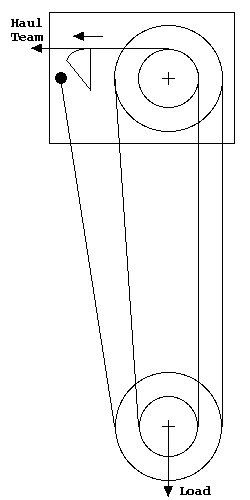 I acquired my CMI Uplift from John E. Weinel, Inc. in 1999. I acquired another in 2017 as part of Bob Thrun’s collection.
I acquired my CMI Uplift from John E. Weinel, Inc. in 1999. I acquired another in 2017 as part of Bob Thrun’s collection.
The CMI Uplift is 257 mm. tall, 100 mm. wide, and 62 mm
thick. Mine weighs 1054 g.
When I described the SRT
handled ascenders, I commented that they appeared to have
copied the C.M.I.
5000 extrusion. It appears that CMI has returned the favor
and copied many aspects of the SRT
RM22 Rescuemate.
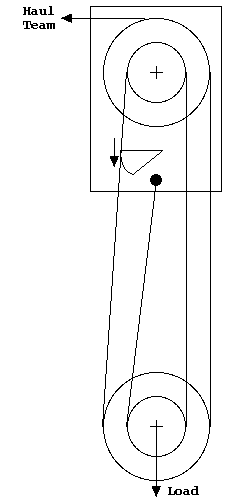 The CMI Uplift is a double pulley with an eccentric cam that
prevents one strand of rope from entering the device. The central
frame is an anodized aluminum extrusion with a rectangular channel
for mounting the cam and a 17 mm. U-shaped channel for the rope.
The cam is a CMI cam that has been modified to use a hold-open
safety that is virtually identical to the one on the SRT
Rescuemates, and is riveted to the frame just like the SRT Rescuemates. It is a pity that
this wasn't bolted on so that the cam could be replaced when worn.
A 3 mm. cord is tied to the cam in the same manner as on the SRT Rescuemates, which allows the
cam to be opened remotely. On the back of the frame there is a
cord lock that is almost identical to the SRT
Rescuemates, including being mounted with an Allen-head cap
screw. There is a rope guiding post that is, once again, a copy
of the one on the SRT Rescuemates,
complete with the nonfunctional groove. There is a carabiner hole
at the bottom of the device.
The CMI Uplift is a double pulley with an eccentric cam that
prevents one strand of rope from entering the device. The central
frame is an anodized aluminum extrusion with a rectangular channel
for mounting the cam and a 17 mm. U-shaped channel for the rope.
The cam is a CMI cam that has been modified to use a hold-open
safety that is virtually identical to the one on the SRT
Rescuemates, and is riveted to the frame just like the SRT Rescuemates. It is a pity that
this wasn't bolted on so that the cam could be replaced when worn.
A 3 mm. cord is tied to the cam in the same manner as on the SRT Rescuemates, which allows the
cam to be opened remotely. On the back of the frame there is a
cord lock that is almost identical to the SRT
Rescuemates, including being mounted with an Allen-head cap
screw. There is a rope guiding post that is, once again, a copy
of the one on the SRT Rescuemates,
complete with the nonfunctional groove. There is a carabiner hole
at the bottom of the device.
The two anodized aluminum pulleys are 67 mm. in diameter, which
is larger than those on the RSI Rescue
Hauling Pulley or the SRT Rescuemates.
This provides better clearance between the rope and the back of
the cam channel than the other designs do. The pulleys can handle
ropes up to 13 or 14 mm. without dragging, and up to 16 mm. with
degraded performance. The pulley side plates are anodized different
colors, so that one can tell the front and back sides of the device
without looking at the cam area. The pulleys and side plates are
bolted to the frame, apparently on a loose-fitting rod with threads
at each end. The pulleys and side plates tend to flop around on
the frame. The pulley bearings are rather good, and allow the
pulleys to turn freely.
No instructions
came with the device. There are two obvious ways to rig the device
for a 4:1 hauling system. In the first, the cam supports one half
of the load while the hauling team resets for another pull. In
the second, the cam supports one fourth of the load, but the frame
pivots with each pull and the rope runs over a portion of the
rope channel that should have been rounded, but wasn't. Thirty
seconds with a rat-tail file will fix this oversight.
Overall, this is a well-made device designed for rescue applications.
Any mechanical advantage system has certain dangers, so it is
important that the team not overstress any components. When rigged
correctly, it is unlikely that this device will be the weakest
link.
[ Top
| Single
| Double
| Uplift
]



